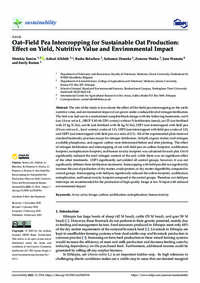Oat–Field Pea Intercropping for Sustainable Oat Production: Effect on Yield, Nutritive Value and Environmental Impact

Authors:
The aim of the study is to evaluate the effect of Oat–field pea intercropping on the yield, nutritive value, and environmental impact of oat grown under a reduced level of nitrogen fertilisation. The trial was laid out in a randomized complete block design with the following treatments: oat-0 (oat (Avena sativa L., SRCP X 80 Ab 2291 variety) without N fertilization (urea)), oat-23 (oat fertilised with 23 kg N/ha), oat-46 (oat fertilised with 46 kg N/ha), O1P1 (oat intercropped with field pea (Pisum sativum L., local variety) a ratio of 1:1), O1P2 (oat intercropped with field pea a ratio of 1:2), and O2P1 (oat intercropped with field pea at a ratio of 2:1). All of the experimental plots received standard husbandry practices except for nitrogen fertilisation. Soil pH, organic matter, total nitrogen, available phosphorus, and organic carbon were determined before and after planting. The effect of nitrogen fertilization and intercropping of oat with field pea on carbon footprint, acidification footprint, eutrophication footprint, and human toxicity footprint was calculated for each plot. Oat-0 significantly reduced the total nitrogen content of the soil, while there was no significant effect of the other treatments. O2P1 significantly out-yielded all control groups; however, it was not significantly different from fertilisation treatments. Intercropping with field pea did not significantly increase the cost of production of dry matter, crude protein, or dry matter digestibility compared to control groups. Intercropping with field pea significantly reduced the carbon footprint, acidification, eutrophication, and human toxicity footprint compared to the control groups. Therefore, oat–field pea intercrops are recommended for the production of high-quality forage at low N input with reduced environmental impact.
